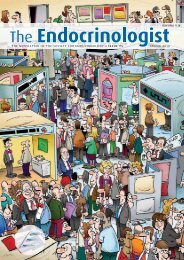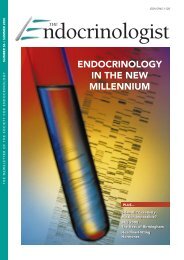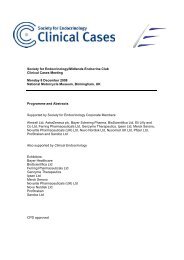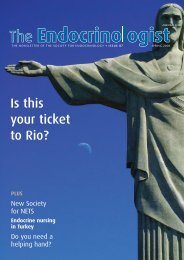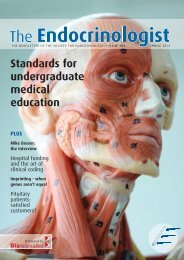The Endocrinologist | Issue 79 - Society for Endocrinology
The Endocrinologist | Issue 79 - Society for Endocrinology
The Endocrinologist | Issue 79 - Society for Endocrinology
- No tags were found...
You also want an ePaper? Increase the reach of your titles
YUMPU automatically turns print PDFs into web optimized ePapers that Google loves.
From strength to strength<strong>for</strong> Clinical <strong>Endocrinology</strong> 2006 should be another highly successful year <strong>for</strong>Clinical <strong>Endocrinology</strong>, the <strong>Society</strong>'s clinical journal.Online manuscript submission and handling reducedthe average time to final acceptance to less than 90days in 2005. Publication of accepted papers onlinebe<strong>for</strong>e they appear in print means they are availablemore quickly than ever. Furthermore, the journal'simpact factor has continued to climb, reaching 3.023<strong>for</strong> 2004.To keep the journal at the <strong>for</strong>efront of endocrineresearch and clinical practice, it must continue tohighlight new advances in the clinical management ofendocrine disorders. A new section entitled 'ClinicalPractice Updates' will help achieve this. This first appeared in January 2006, andwe look <strong>for</strong>ward to receiving feedback from readers, as well as manuscriptsubmissions and suggestions <strong>for</strong> this new section.Professor John Connell replaced Paul Stewart, our retiring Senior Editor, in2005. <strong>The</strong> Editorial Board has undergone a new round of appointments andnow includes senior endocrinologists from around the world. Finally, Dr Aart-Jan van der Lely has been appointed as our new Editor <strong>for</strong> Continental Europe.He, Dr Stephen Judd (<strong>for</strong> Australasia) and Dr Bill Young (<strong>for</strong> the Americas) joinus in our commitment to maintain a truly international relevance and impact<strong>for</strong> the journal.JAYNE FRANKLYN AND JOHN CONNELL, SENIOR EDITORSCLINICAL REVIEWLECTURER Dr John Lindsay from the RoyalVictoria Hospital, Belfast, is the 2006Clinical Review Lecturer. His winningabstract was entitled 'Challenges indisease detection and treatment of thehypothalamic-pituitary-adrenal (HPA)axis during pregnancy'. Dr Lindsaygave his lecture at the Clinical CasesMeeting in London on 15 February.Certificate of AdultEndocrine Nursing Congratulations to LindaSmethurst, who has recentlycompleted her Certificate of AdultEndocrine Nursing. Linda is the sixthholder of this award.Congratulations We are delighted to announcethat Council member Prof Steve Atkin(Hull) has been awarded a Chair.NICK HALESOBITUARY Professor Nick Hales FRS was a diabetes researcherof international distinction. Despite 'retiring' 3 years agoand his increasing ill-health, Nick remained passionateabout biomedical science, and continued to supervisestudents and post-docs, write papers and, most notably,think imaginatively about challenging problems inbiomedicine.Born in Staf<strong>for</strong>d in 1935, Nick read medicine atCambridge, and completed his training at UniversityCollege Hospital. Returning to Cambridge, he undertook aPhD with Philip Randle in the Biochemistry Department.At that time, radioimmunoassay methodology was in itsinfancy, and Nick developed an insulin assay which wasreliable and capable of reasonable throughput. Hismethod was rapidly commercialised and became thebasis <strong>for</strong> the first widely used insulin assay. Thisachievement led to many attractive offers to move acrossthe Atlantic, but Nick decided to stay in Cambridge, andbecame a lecturer in biochemistry.He developed the novel immunoradiometric assayusing radiolabelled antibodies to measure insulin and otherpeptide hormones with great specificity and sensitivity. In aseminal Nature paper of 1968, he predicted the use ofenzymatic rather than radioactive labels. Diagnostic testsbased on such labelled antibodies are now used worldwidein countless clinical and research applications.He became Professor ofChemical Pathology and Head ofthe cognate NHS department inCardiff in 1970. In 1977 he returnedto Cambridge, again to head a jointuniversity and NHS department, analliance that he greatly valued.During a sabbatical in Seattle in 1984, he and Dan Cookdescribed an ATP-sensitive K + channel in pancreatic β cells,and correctly suggested that it might be the link betweencellular metabolism and insulin secretion.Following a chance encounter with David Barker in1988, Nick became fascinated by Barker's suggestions thatprenatal events could influence later health. He dedicatedthe remainder of his scientific life to putting mechanisticflesh on these epidemiological bones. His Nature reportwith Sue Ozanne in 2004, describing the adverse effectson longevity of even a short period of early postnataloverfeeding after intrauterine nutritional deprivation,caught the world's attention, and fuelled increasedinterest in the topic of nutritional programming.He was a hugely supportive, enthusiastic and highlysocial head of department, with a great fondness <strong>for</strong>combining good beer and science. He is survived by hischildren Tim and Kate and his wife Margaret.STEPHEN O'RAHILLY4 THE ENDOCRINOLOGIST • ISSUE <strong>79</strong> • SPRING 2006
His mindHis bodyHis spiritHis TestimJohn is among the 1 in 10 men over 50with late-onset hypogonadism (LOH). 1New Testim Gel, is doing far more thanjust normalising his testosterone level. 2This new patient-friendly approach totestosterone replacement therapy (TRT) isalso helping to address the symptomsassociated with LOH like increased body fat,reduced bone mineral density, low mood,sexual dysfunction and a generally reducedsense of well being. 2-4And John feels in control of his life again.Far more than just the rightlevel of testosteronePRESCRIBING INFORMATION Testim® 50mg Gel (testosterone)Presentation: Tube of 5g containing 50mg testosterone in a clear gel.Indications: Testosterone replacement therapy <strong>for</strong> male hypogonadismwhen testosterone deficiency has been confirmed by clinical features andbiochemical tests. Dosage: One 5g tube daily. If serum testosteroneconcentrations are below the normal range, the dose may be increased from50mg (one tube) to 100mg (two tubes) once daily. Once the tube is opened,apply immediately to clean, dry, intact skin of the shoulders and/or upperarms, preferably in the morning. Do not apply to genital area. Children: Not<strong>for</strong> use in children. Not clinically evaluated in males under 18 years of age.Contraindications: Known or suspected prostate or breast cancer.Hypersensitivity to testosterone or any excipients of the gel. Warnings andPrecautions: Prior to therapy, exclude prostate cancer. Examine breast andprostate gland at least annually and twice yearly in elderly or at risk patients(clinical or familial factors). Monitor serum calcium levels in cancer patientsat risk of hypercalcaemia/hypercalciuria. Testosterone may cause oedemawith or without congestive cardiac failure in patients with severe cardiac,hepatic or renal insufficiency. In this case, stop treatment immediately. Usewith caution in patients with hypertension, ischaemic heart disease, epilepsyand migraine. Possible increased risk of sleep apnoea in patients who areobese or with chronic respiratory disease. Improved insulin sensitivity mayoccur. Irritability, nervousness, weight gain, prolonged or frequent erectionsmay indicate excessive androgen exposure requiring dosage adjustment. Ifsevere application site reactions occur, discontinue if necessary. Periodicallymonitor testosterone concentrations, full blood count, lipid profile and liverfunction. Testosterone may produce a positive reaction in anti-doping tests.Not <strong>for</strong> use in women. <strong>The</strong> gel may be transferred to others by close skin toskin contact, which could lead to adverse effects (inadvertentandrogenisation) on repeated contact. In<strong>for</strong>m the patient about transfer risk,which can be prevented by covering or washing the site prior to contact.Testim Gel should not be prescribed <strong>for</strong> patients who may not comply withsafety instructions (e.g. severe alcoholism, drug abuse, severe psychiatricdisorders). Pregnant women and children must avoid any contact withapplication sites. Interactions: Interactions reported with oralanticoagulants, ACTH or corticosteroids, propranolol and thyroxine-bindingglobulin in laboratory tests. Side effects: Common (4%): skin reactions andincreased PSA. Also reported: worsening hypertension, acne, rash,application site reactions, gynaecomastia, increased haematocrit, red bloodcell count and haemoglobin. Other known reactions to testosteronetreatments: prostate abnormalities and prostate cancer, pruritus,vasodilation, emotional lability, nausea, alopecia, cholestatic jaundice,generalised paresthesia, hirsutism, seborrhoea, decreased libido, anxiety,altered blood lipid levels including a reduction in HDL cholesterol andalteration in liver functions tests. In high dose, prolonged treatment:electrolyte disturbances, oligospermia, frequent and/or prolonged erections.NHS Cost: £33.00 per pack of 30 x 5g tubes POM: PL 06958/0027 MAholder: Ipsen Ltd, 190 Bath Road, Slough, Berks SL1 3XE Date ofpreparation: March 2005. Testim® Gel is a registered trademark.References: 1. Harman SM et al. J Clin Endocrinol Metab 2001; 86: 724-731.2. McNicholas TA et al. BJU Int 2003; 91:69-74. 3. Steidle C et al. J ClinEndocrinol Metab 2003; 88:2673-2681. 4. Dean JD et al. Rev Urol 2004;6(Suppl 6):S22-S29.© Ipsen 2005 T2771A August 2005
Committee News<strong>The</strong> latestfrom each ofthe <strong>Society</strong>'sCommittees.Finance<strong>The</strong> Committee have discussed thebudgets <strong>for</strong> the year 2005-2006. <strong>The</strong>yalso agreed that the financial year-endshould be changed to 31 July, in lightof the AGM taking place in spring from2007. <strong>The</strong> review of investmentmanagers requires some furtherenquiries to be made about one of thepotential companies, following achange in their status. JuliaBuckingham's term on the Committeehas ended, and members are asked tonominate a replacement (see page 3).NursesKaren Campbell (Glasgow), ChristineGibson (Manchester) and Viv Thornton-Jones (Ox<strong>for</strong>d) have been elected tothe Committee from 1 January 2006.We thank Morag Middleton and PhilipYeoh <strong>for</strong> their contributions over thepast 4 years. Margaret Miller willremain on the Committee <strong>for</strong> a furtheryear as a co-opted member.Programme<strong>The</strong> Committee have discussed theprogramme <strong>for</strong> the 197th Meeting ofthe <strong>Society</strong> (6-7 November 2006,Kensington Town Hall), and the 2-daymeeting’s exciting content will reflectthat it is the Diamond Jubilee.<strong>The</strong> medal lectures will include anadditional Jubilee Medal Lecture.<strong>The</strong> preliminary programme will besent to members in May 2006.Publications<strong>The</strong> <strong>Society</strong>'s current publicationsprogramme was reviewed. <strong>The</strong>Committee thanked Marc Lippman,who retired as Editor-in-Chief ofEndocrine-Related Cancer at the end of2005. <strong>The</strong> <strong>Society</strong> had commissionedan independent report on a possibleconflict of interest between thepublishing activities of BioScientificaand the <strong>Society</strong> of <strong>Endocrinology</strong>. <strong>The</strong>Committee reviewed the report andaccepted its finding that the structureof the two bodies meant that no suchconflict arose. <strong>The</strong>re was muchdiscussion of recent developments inopen archiving and repositories, andhow the <strong>Society</strong> should respond tothe activities of several researchfunding bodies in this area.Young <strong>Endocrinologist</strong>sKim Jonas (London) and MabroukaMaamra (Sheffield) were welcomedto the Group.Strategy Update<strong>The</strong> Strategy Awayday took place atthe end of November. Its main aimswere to agree new ways of supportingendocrinology, to decide how tosupport the <strong>Society</strong>'s growth, and tostrengthen our governance of the<strong>Society</strong>. A full report will follow.Feedback from the questionnaire thatmembers received last October can befound on pages 8 and 9 of this issue.Biosciences Federation <strong>The</strong> Biosciences Federation represents over 70 000 life scientists and aimsto provide decision makers with a single authority on the life sciences. <strong>The</strong>Federation is committed to dialogue on the ways in which science can helpdeliver the Government's aims. It recently invited its 38 member organisationsto recommend science policy priorities <strong>for</strong> the recently elected Government, inorder to progress its 10-year plan. <strong>The</strong> top six priorities that the Federation hascommended to Government <strong>for</strong> the next 5 years are as follows.Attracting, training and retaining world class scientists - this is crucial tomaintain the UK science base. <strong>The</strong> value of a science degree in all employmentsectors must be emphasised, while those who choose to follow a scientificcareer must be fairly rewarded.Stimulating public enthusiasm <strong>for</strong> science and technology - the publicperception of science has an enormous impact on how policies are <strong>for</strong>mulated,the type of research that can be conducted, and on the attractiveness of the UKas a place to do science.Ensuring that public policy is underpinned by sound science - publicpolicy should be based on the best research and an appreciation of thedeficiencies in the available in<strong>for</strong>mation. Good policy-making depends on astrong scientific culture within Government departments.Promoting more effective commercialisation of science - exploitation ofscience and engineering by academic institutions requires access to staff whocan manage commercial enterprises.Ensuring strategic science provision in higher education - withdrawal ofcourses is beginning to impinge severely on the full breadth of biology, particularlyin applied areas of biology. <strong>The</strong> real costs of delivering such courses are oftenunderestimated. As modern science is cross-disciplinary, the closure of physicalscience courses is also a potential threat to the future of biosciences research.Fostering closer links with theEuropean science base - sciencedoes not respect internationalboundaries. Strengthening Europeanresearch overall will help the UKachieve the challenging targets setout in the 10-year Science andInnovation Framework.For more in<strong>for</strong>mation, see theBiosciences Federation web site atwww.bsf.ac.uk.New head <strong>for</strong>Biosciences FederationRichard Dyer replaced Mike Withnallas Chief Executive of the BiosciencesFederation inJanuary 2006.Prior to thisappointment,Dr Dyer wasDirector and ChiefExecutive of theBabrahamResearch Institutein Cambridge.6THE ENDOCRINOLOGIST • ISSUE <strong>79</strong> • SPRING 2006
From EFES to ESE <strong>The</strong> European <strong>Society</strong> of <strong>Endocrinology</strong> (ESE) waslaunched on 1 January 2006. Its mission is to promote allaspects of endocrinology and to define endocrine care inan expanding Europe. It will stimulate exchange andeducation, put endocrinology much more firmly on theresearch agenda of the European Community, and inparticular involve all 13 000 individual European basic andclinical endocrinologists more actively in strengtheningthe role, the status and the impact of the specialism.ESE replaces EFES (the European Federation ofEndocrine Societies), which had achieved a great deal inthe last 22 years. <strong>The</strong> decision to establish ESE in place ofEFES was taken following careful consultation, to allowthe necessary development of the organisationsupporting European endocrinology.ESE has three categories of membership:Ordinary membership is open to researchers,clinicians and students in the field of endocrinology andhormonal systems. <strong>The</strong>se members have voting rightsand can attend general meetings. Benefits includereduced rate registration at the European Congress of<strong>Endocrinology</strong> and any other ESE events, access to a webbaseddirectory of European endocrinologists, a bi-annualnewsletter and email alerts advising of news and grants.<strong>The</strong>y also receive a reduced rate subscription to EuropeanJournal of <strong>Endocrinology</strong>, Journal of <strong>Endocrinology</strong>,Endocrine-Related Cancer, andJournal of Molecular <strong>Endocrinology</strong>.Affiliated society membershipis open to national endocrinesocieties and pan-European subspecialistendocrine societies inEurope. All previous full andaffiliated members of EFES haveautomatically become affiliated societies of the ESE, will haveone vote per society and can attend general meetings. Fordetails of the current affiliated societies see www.euroendo.org.Benefits will include the ability to nominate ECElocations, voting rights, in<strong>for</strong>mation on developments inEurope and access to representation in Brussels.Corporate membership is open to companiesworking in the field of endocrinology. <strong>The</strong>re are no votingrights associated with this category of membership, butmembers can attend general meetings. Benefits includepriority booking and discounts when exhibiting at orsponsoring ESE congresses or other events, and access toEurope's opinion leaders.All attendees at ECE 2006 in Glasgow, UK, on 1-5 April2006 will be invited to become members of the ESE freeof charge <strong>for</strong> 2006 (see www.ece2006.com <strong>for</strong> details).To find out more about ESE and membership go towww.euro-endo.org.European <strong>Society</strong>of <strong>Endocrinology</strong>Florinef shortageThis is an extract from a letter to the <strong>Society</strong> from Bristol-Myers Squibbon the current shortage of Florinef. ‘Bristol-Myers Squibb is carefully managing stocks of Florinef as somelimitation has arisen during the process of transferring manufacturing to anew site. I would like to reassure you that Bristol-Myers Squibb currently hassufficient supplies of Florinef to meet the demand <strong>for</strong> human use only. Weare making regular deliveries to the major wholesalers to ensure continuityof supply. We have also now been successful in establishing supplies <strong>for</strong> theveterinary community from a different source.Pharmacists and patients should not have any difficulty obtainingFlorinef. However should this situation arise we have made provision <strong>for</strong>pharmacists, and patients via their pharmacist to order supplies of Florinefdirectly from our Customer Services department tel: 01244 586 251, referredto as "special orders". If you do receive any reports of pharmacists or patientsstruggling to obtain Florinef please would you refer them to our CustomerServices department. <strong>The</strong>ir order will then be dispatched immediately.’Royal <strong>Society</strong> Rosalind Franklin Award <strong>The</strong> Royal <strong>Society</strong> invites nominations <strong>for</strong> the 2006 Rosalind Franklin Award.This annual award takes the <strong>for</strong>m of a medal and £30 000. It is made to anindividual <strong>for</strong> an outstanding contribution to any area of natural science,engineering or technology. It is funded by the DTI's Office of Science andTechnology, as part of its ef<strong>for</strong>ts to promote women in these disciplines. It ismade to someone in mid-career, ideally between 5 and 25 years after the startof their PhD, and actively involved in scientific research. For further in<strong>for</strong>mationsee www.royalsoc.ac.uk/page.asp?tip=1&id=1782.BONERESEARCHSOCIETY <strong>The</strong> Bone and Tooth <strong>Society</strong> hasrecently changed its name to theBone Research <strong>Society</strong>, to accuratelyreflect the <strong>Society</strong>'s modern remit.<strong>The</strong> new name is accompanied by anew web site, at www.brsoc.org.uk.More in<strong>for</strong>mation about the BoneResearch <strong>Society</strong> is available from theSecretary, Tim Arnett (Tel: 020-76<strong>79</strong>3309; Email t.arnett@ucl.ac.uk).<strong>The</strong> <strong>Society</strong> will be meeting jointlywith the British OrthopaedicResearch <strong>Society</strong> <strong>for</strong> the first timethis year. For further details, seewww.brs-bors-2006.org.THE ENDOCRINOLOGIST • ISSUE <strong>79</strong> • SPRING 20067
What members want…% REPLIES <strong>The</strong> <strong>Society</strong>'s renewed healthy financial positionmeans we can develop further over the next 5 years, aswell as maintaining our current services. Last year, weasked <strong>for</strong> your views on how we should spend the<strong>Society</strong>'s funds, and the new areas we should develop.Your responses <strong>for</strong>med an important part in shapingthe conclusions of the <strong>Society</strong>'s recent Strategy Awayday.We are very grateful to all members who replied to thequestionnaire and made it such an in<strong>for</strong>mative exercise.As you can see below, the returned questionnairesprovide an important insight into the views of themembership. <strong>Society</strong> demographics at the end ofOctober showed that, of the 1802 members, 53% wereclinical, 38% were basic scientists and 5% were NurseMembers (others were unspecified). Furthermore, 73%were Ordinary Members, 18% Junior Members, 9% SeniorMembers and 1% Honorary Members.Figure 1. Respondents' areas of workNB Figures are over 100% as repondents could select more than one area5040302010043%BasicScience33%33%Clinical Science/Research/ ClinicalClinical Practice Research/Clinical Practice14%ClinicalPracticeA total of 137 members (8%) responded to thequestionnaire. <strong>The</strong> typical respondent was a UK-based,Ordinary Member under the age of 40. Figure 1 showshow the respondents classified their areas of work.Figure 2. Satisfaction with the <strong>Society</strong>'s work% REPLIES5040302040%37%6%4%4%Unstated Nursing OtherThose who responded were very happy overall with thework of the <strong>Society</strong> (Figure 2): 77% were either very or fairlysatisfied, compared with 3% who were fairly dissatisfied. 1%stated that they were dissatisfied with the work of the<strong>Society</strong>, but un<strong>for</strong>tunately we do not know why, nor do weknow their academic background.When the data relating to basic scientists and clinicianswere compared, the results <strong>for</strong> the two groups were verysimilar. More than three-quarters were at least satisfied.None of the basic scientists was dissatisfied with the <strong>Society</strong>and only 4% of clinical members stated that they were fairlydissatisfied. Once again we un<strong>for</strong>tunately have no furtherin<strong>for</strong>mation about the source of their dissatisfaction.One of the questionnaire's main aims was to discoverwhat the membership think of the <strong>Society</strong>'s current services.Respondents were able to state whether they would like tosee current services expanded, reduced or kept as they are.Figure 3 shows that most respondents would like the<strong>Society</strong> to provide more opportunities <strong>for</strong> continuousprofessional development (<strong>for</strong> all membership types), morepromotion of endocrinology to the public, more fellowshipsand studentships, more travel grants and more educationalmaterials available on the web.Respondents would like the <strong>Society</strong>'s clinical positionstatements and science policy statements, the publicationof the newsletter, books and journals, and the number oftraining courses and conferences to remain at the currentlevel.No areas were highlighted by the majority ofrespondents <strong>for</strong> a reduction in the level of serviceprovided by the <strong>Society</strong>, which is very encouraging.To gauge members' support <strong>for</strong> specific services, thequestionnaire asked how strongly they agreed withvarious statements.<strong>The</strong> first was whether '<strong>The</strong> <strong>Society</strong> should increase itssupport <strong>for</strong> younger members' (e.g. grants and otherservices to attract young scientists and doctors intoendocrinology, grants and career support to keep youngscientists and doctors in endocrinology, prizes <strong>for</strong>outstanding young endocrinologists, lobbying to improvecareer structure).Strongly Agree Disagree Stronglyagree (%) (%) (%) disagree (%)Total 52 39 3 0Clinicians 49 41 3 0Basic Scientists 60 35 2 0Table 1 – Agreement that the <strong>Society</strong> should increase support<strong>for</strong> younger members100Very Satisfied13%3%Fairly Satisfied Neither Satisfied Fairly Dissatisfied Dissatisfied No Commentnor Dissatisfied1%6%<strong>The</strong> <strong>Society</strong> was very encouraged by the responses(Table 1), which clearly demonstrated that mostrespondents strongly support this area of work. As a result,one of the main items at the Awayday was how the <strong>Society</strong>can recruit and retain an increasing number of youngpeople (scientists, clinicians and nurses) into endocrinology.8 THE ENDOCRINOLOGIST • ISSUE <strong>79</strong> • SPRING 2006
Respondents were also asked whether '<strong>The</strong> <strong>Society</strong>should increase public awareness of endocrinology' (e.g.web-based public/patient in<strong>for</strong>mation resources,increased public relations activities, school materials).Strongly Agree Disagree Stronglyagree (%) (%) (%) disagree (%)Total 33 48 11 2Clinicians 40 45 5 3Basic Scientists 28 65 5 0Table 2 – Agreement that the <strong>Society</strong> should increase publicawareness of endocrinologyAs with the first statement, most respondents agreedoverall that the <strong>Society</strong> should increase the public'sawareness of endocrinology (Table 2). We weredisappointed that a small percentage of respondents(interestingly, clinically focused) did not support thisobjective, especially as the advancement of educationand research in endocrinology <strong>for</strong> the public benefit is the<strong>Society</strong>'s prime charitable aim.<strong>The</strong> questionnaire also gave members ampleopportunity to comment on any area of the <strong>Society</strong> thatthey felt could improve. This resulted in an extensive,varied list of comments, including grant issues, basic andclinical careers, education in schools, publishing,interaction with Europe, meetings and administrativematters! Further details of these comments can beobtained from rachel.evans@endocrinology.org.This exercise has provided the <strong>Society</strong> with an invaluableinsight into your thoughts. We hope to be able to act uponmany of the issues raised, to support our members, tostrengthen endocrinology as a discipline and also to increaseawareness and understanding of endocrinology by thepublic.A detailed report of the Awayday will be presented tothe <strong>Society</strong>'s Council in March, followed by an article in<strong>The</strong> <strong>Endocrinologist</strong>. <strong>The</strong> report will also be publiclyavailable at www.endocrinology.org.For further in<strong>for</strong>mation about the membershipquestionnaire, contact Rachel Evans at the Bristol office(rachel.evans@endocrinology.org).Figure 3. Support <strong>for</strong> the <strong>Society</strong>'s current servicesClinical PositionStatementsScientific PolicyStatementsCPDPromotingto PublicFellowshipsStudentshipsTravel GrantsWeb MaterialsNewsletterBooksJournalsTrainingCoursesConferences0Less More Keep the same2040 60 80 100% REPLIES4%42%45%6%35%52%3%53%38%3%53%36%3%64%26%1%63%27%0.7%61%32%1%63%28%7%9%75%9%22%69%4%8%80%2%36%55%6%13%69%11 July Molecular<strong>Endocrinology</strong>Workshop12-13 July AdvancedEndocrineCourse11-14 July 2006THE MÖLLER CENTRE, CAMBRIDGE14 July ClinicalPractice DayClinical Practice Day Abstract Deadline: 12 April 2006Grants are available <strong>for</strong> <strong>Society</strong> members to attend the Molecular <strong>Endocrinology</strong> Workshop.See www.endocrinology.org/sfe/grants.htm <strong>for</strong> further details.Deadline <strong>for</strong> grant applications 15 April 2006THE ENDOCRINOLOGIST • ISSUE <strong>79</strong> • SPRING 20069
Fat hormones of brain origin:roles and regulations? <strong>The</strong> brain was recognised as a major site of peptidebiosynthesis 30 years ago, and more than 50neuropeptides are now known. AGE Pearse proposedthe accepted view that many peptides are common togut and brain, one recently discovered example beingthe hormone ghrelin. With such precedents in mind, it ispuzzling that adipose-specific peptide hormones likeleptin have attracted little attention as putativeneurotransmitters or neuromodulators.<strong>The</strong> discovery of the adipocyte-derived factor leptinwas a key event in the study of energy balance and bodyweight regulation. Leptin is just one of a large family offactors secreted by adipocytes (adipokines). <strong>The</strong>se includethe familiar (resistin, adiponectin), the new (fastinginducedadipose factor (FIAF), visfatin, vaspin) and theunexpected (nerve growth factor).Leptin receptors are widely distributed in rodent andhuman brains. This led us to hypothesise that many ofthese, apart from those in the basal hypothalamus, wouldonly be accessible to a brain-derived ligand, if not leptin ofbrain origin. We subsequently demonstrated that rat brainexpressed leptin mRNA, and that leptin immunoreactivitycould be co-localised with neuronal markers like NeuNand oxytocin. Leptin mRNA was found to be readilydetectable in human, guinea pig, hamster, sheep, pig andfish brain, and in human neuroblastoma and ratglioblastoma cells. In vivo investigations demonstratedthat leptin was secreted by the human brain.However, failure to detect leptin mRNA in murine brainhas profoundly influenced current thinking on its physiology.All the central effects of this adipokine are assumed to resultfrom circulating peripheral leptin entering the brain, perhapsvia a saturatable transport mechanism, and binding to leptinreceptors. <strong>The</strong> widespread acceptance of this view, basedsolely on mouse data, neglects findings in other species thatsuggest brain-derived leptin may have neurotransmitter,neuromodulator or neurotrophic properties.We extended our original hypothesis to include otheradipokines. Genes <strong>for</strong> resistin, FIAF and adiponectin aresignificantly transcribed in rat and mouse brain and pituitarygland. In addition, we have shown that the supposedlyadipose-specific membrane protein adiponutrin is expressedin mouse brain. Maddineni and colleagues have recentlydetected adiponectin mRNA in chicken brain and pituitary.We do not know why leptin expression is suppressedin the mouse CNS. Literature predating our findingssuggests that mice have evolved unique mechanisms ofenergy regulation. Notwithstanding this, a detailedinvestigation of brain-derived adipokines, and theireffects on brain function, is justified by the evidence fromother species, including our studies showing modulationof these brain-derived adipokines by nutrients.<strong>The</strong> heterogeneous distribution of leptin receptors inextra-hypothalamic brain regions, like cerebellum, cerebralcortex, substantia nigra and hippocampus, suggests thatleptin probably modulatesneural pathways distinctfrom those related to bodyweight regulation. <strong>The</strong>reare limited data on otheradipokine receptors in thebrain. Resistin receptorshave not yet beenidentified, though central injection of resistin stimulates c-fos expression in the hypothalamus. Two adiponectinreceptors have been cloned and localised to brain tissue,including the hypothalamus.Some of the earliest investigations of obese mousemutants revealed that the total absence of leptin (ob/obmice) or leptin receptors (db/db mice) was associatedwith diminished brain weight and DNA content. Morerecent studies have shown that glial and synapticproteins, and hypothalamic neuronal projections, arereduced in these mice. Leptin treatment of neonatalob/ob mice reversed these changes. A recent report thatgrey matter tissue composition in leptin-deficient adulthumans is increased following leptin injections is ofinterest. We hypothesise that brain-derived leptin mayfunction as a developmental signal to regulate brainmaturation. However, little in<strong>for</strong>mation is available ongenetically or phenotypically diabetic/obese rats.Structural abnormalities were reported in brain tissuefrom fa/fa rats, and central leptin injection re-establishedinsulin sensitivity in streptozotocin-induced diabetic rats.Experiments in rat hippocampus indicate that locallyreleased, brain-derived leptin could influence long termpotentiation (LTP). Harvey and coworkers have recentlyimplicated leptin in hippocampal synaptic plasticity viaenhancement of glutamate (NMDA) receptor function. Inaddition, leptin-mediated LTP is associated with improvedspatial memory. Knocking down, or silencing, brain leptinexpression will be critical in distinguishing between thecontributions of peripheral and central leptin in theseprocesses. Such an approach is now feasible. Inpreliminary experiments we have successfully used RNAinterference to silence leptin gene expression in vitro.Central adipokines may also be importantcomponents of the central inflammatory response tobrain injury. This would be consistent with suggestions byTrayhurn and Wood that adipose-derived adipokines areindicators of the chronic low grade inflammation found inobese patients. We recently detected significant increasesin FIAF and resistin gene expression in mouse brain aftera hypoxic/ischaemic injury, or after a peripheral injectionof the bacterial endotoxin lipopolysaccharide.<strong>The</strong> data suggest that brain-derived adipokinesshould be considered as possible neurotransmitters, asneuromodulators, as trophic factors and as indicators ofbrain damage. Fat hormones of brain origin thusrepresent an intriguing new field of inquiry.MICHAEL WILKINSON10 THE ENDOCRINOLOGIST • ISSUE <strong>79</strong> • SPRING 2006
Doctors who sport Many doctors play some <strong>for</strong>m of sport. However, inthat world of endeavour, their ability may not correlateclosely with their status in medicine. Nonetheless,position in the medical hierarchy may occasionally beexploited to close a wide gap in sporting prowess. Oneexample that comes to mind is a squash match I onceplayed against Billy, my SHO at the time. Given that Iwas but a moderate journeyman of a player and he wasan ex-junior Wimbledon tennis star, I knew I wasdestined to come second. That was until there was aliteral 'turn' of events in the eighth minute of the matchwhen he twisted his ankle.'What do you want me to do, sir?' he asked.'Play on, Billy,' I replied unsympathetically.<strong>The</strong> rest of the match consisted of front wall dropshots. Billy accepted defeat in the full knowledge that hisreference was preserved. Meanwhile I consoled him withthe thought that I usually preferred my opponent to be inthe throes of acute meningitis to be certain of victory.I was less pleased when I met Luis. At that time I wasstill playing soccer, but my game had receded fromengine room all-action assassin to run-down midfielddynamo who had lost his ability to hover. I was stillturning out <strong>for</strong> the village third team, however, and onlythe previous Saturday, in the 67th minute, I had managedto head the ball onto the opposition crossbar from acorner. Luis was introduced to me in the clinic by acolleague.'Luis is Uruguayan and he is here as a British CouncilFellow; you will like him as he is keen on football,' I was told.Luis was small and unremarkable in appearance.Knowing his football interest, I felt sure that there wouldbe an opportunity to boast to him about the 67th minuteheader but I elected, out of misguided politeness, to firstask him if he had ever played football.'Yes,' he said.'What was the name of your team?' I asked.'Uruguay,' he replied.My heart sank! <strong>The</strong> village soccer reminiscence wasout of the question. It was getting worse by the minute,as Luis told me that he had played in the 1970 World Cuptournament <strong>for</strong> Uruguay against Brazil and marked thegreat Pele.'All down his back, no doubt,' I muttered softy undermy breath, anxious to avoid any possibility of a SouthAmerican 'kiss'!My worst experience of a sporting interaction with afellow medic, however, was in the annual hospital squashtournament. I was a junior research fellow at the timeand, as luck would have it, I drew the Professor ofMedicine as my opponent.I had seen him play previously at the local squashclub. He always played with the same colleague, anArgentinian radiologist whose English was moderatelyincomprehensible, but whose body position whenreceiving serve was even stranger, with his non-racquetholdinghand swathing his testicles. When confrontedabout this non-classical stance, he explained that he hadplayed a great deal of football in his youth. Hands overthe scrotum were mandatory if lined up in an Argentiniansoccer wall, and he consequently continued the habit inall other sports!For me, however, the Professor was a more irritatingopponent. He was 15-20 years older than me and hisbody scarcely contained any muscle of note. I tore aroundthe court, chasing everything and living off scraps, whilsthe scarcely moved, just flicked his wrist to make anotherpoint disappear. At the end of each game he lit a cigaretteand quaffed his pint of beer! In comparison my body hadbeen treated like a temple, as I had not drunk alcohol <strong>for</strong>2 weeks in anticipation of the match. Even worse was howhe treated me on court: when I did manage a half-decentreturn he would say 'Good shot, Hadyn!'This last 'habit' drove me nuts.It would have been bad enough if myname was actually Hadyn... Was he playing mind games,this spin-professor? Either way I lost the match 3-1and felt like murdering him.Gradually the passing of time has allowed me tosuppress memories of the encounter. That is until lastweek, some 20 years after the infamous squash match,when I happened to go to the sports club in the lunchhour. I couldn't believe my eyes. <strong>The</strong>re in the changingroom were the Professor with a fag and a pint of beer, andhis testicle-clutching incomprehensible Argentiniancompanion, about to embark on a game of squash. I wasoff to the gym, but we all met again in the changing roomafter our physical ef<strong>for</strong>ts were completed. A lovely chatabout the old days and <strong>for</strong>mer colleagues ensued, butjust as I was about to leave, and whilst his Argentiniancolleague was in the shower using his one free hand tojuggle with the soap, the Professor beckoned me over.'A rather awkward question I'm afraid, a personalquestion that has perplexed me and my South Americanfriend,' he said.'Anything, ask away,' I replied.'What's your name?' he asked.His question sent a warm glow of satisfaction throughmy body, as I promptly replied, 'Hadyn!'I was happy to see that age had not diminished himand yet, at the same time, it had mellowed me.'HOTSPUR'THE ENDOCRINOLOGIST • ISSUE <strong>79</strong> • SPRING 200611
NO's role in the oviductNitric oxide (NO) has emerged as amajor paracrine mediator, producing awide range of effects on reproductiveprocesses. Production of NO is assistedby the enzyme NO synthase (NOS). Toinvestigate a potential specific localregulatory role in oviduct function,Ulbrich and colleagues looked at NOSmRNA and protein expression andlocalisation during the bovineoestrous cycle, and their response tooestradiol-17β and progesterone.Levels of endothelial NOS (eNOS)increased throughout the oestrouscycle to reach highest levels at prooestrous,an effect most pronouncedin the ampulla of the oviduct.Inducible NOS (iNOS) was maintainedat high levels in the ampulla, whileinitial low levels in the isthmus rose atday 3.5, then declined again towardspro-oestrous. Absolute expression ofiNOS was higher than eNOS and itsregulation more pronounced,implying that eNOS is responsible <strong>for</strong>constitutive NO expression while iNOSmaintains cyclic expression.<strong>The</strong> hypothesis is thatdownregulation of iNOS in theisthmus exerts a possible impact onthe contractile response and increasesoviduct motility by increasing circularsmooth muscle activity. <strong>The</strong> authorsconclude a physiological influence ofboth NOS iso<strong>for</strong>ms in supportingsuccessful fertilisation by regulatingthe oviduct environment. HJ(See the full article in Journal of<strong>Endocrinology</strong> 188(2), February 2006)Does GH cause cancer?Circumstantial evidence linking GHand cancer has recently raisedconcerns regarding the use of GHtherapy. <strong>The</strong> powerful proliferativeand anti-apoptotic effects of GH'smediator IGF-I may contribute toconditions favouring tumourigenesis.In this article, Jenkins andcolleagues evaluate various evidenceregarding the potential influence ofGH/IGF-I on cancer development,including studies of de novo andrecurrent cancer in GH therapy patients,and acromegaly. <strong>The</strong> evidence citedsupports an association of increased GHwith cancer, but the authors concludethat evidence <strong>for</strong> physiological doses ofGH increasing the incidence oftumourigenesis is limited, and theHOTTOPICSHelen Jaques, Vicki Norton, JayanthiMondi and Andrew Lowe bring youhighlights from the latest research inthe <strong>Society</strong>'s journals.potential risks of simply returning GHlevels to normal are likely to be minor.<strong>The</strong> authors do, however, stress theneed <strong>for</strong> longer-term follow-up.In the same issue, Holly and Perks'commentary asks whether this issueis being approached correctly. <strong>The</strong>authors stress the importance ofinternal and external environmentalfactors in cancer development. <strong>The</strong>yconclude that, given IGF-I's key role inthe internal environment, theimportant question is 'will GH therapyalter the internal environmentallowing more preclinical neoplasiasto become cancers?'. Currently thereis no easy answer to this question. VN(See the full article in Clinical<strong>Endocrinology</strong> 64(2), February 2006)Neurohypophysialabnormalities withUncx4.1<strong>The</strong> hypothalamo-neurohypophysialsystem (HNS) consists of magnocellularneurones producing the peptidehormones vasopressin and oxytocin. Anumber of transcription factors havebeen implicated in HNS development.Null mutations of these factors causesevere defects in proliferation,migration and survival during earlyembryogenesis. While these tell usabout the early events in HNSdevelopment, no insights intomechanisms of late development andmaturation of this major peptidergicsystem have yet been obtained.Asbreuk and coworkers have nowconducted a screen <strong>for</strong> adultexpressedhomeobox genes andidentified Uncx4.1 as a geneexpressed in adult and embryonicmagnocellular neurones of the HNS.In the <strong>for</strong>mer, they demonstrated anoverlap with vasopressin expression.Furthermore, they examinedknockout mice devoid of Uncx4.1, andshowed that the vasopressin neuronesare viable and that the neuropeptideexpression is apparently not affected.However they found that 50% of themice exhibited abnormal connectionswith the pituitary. <strong>The</strong>se results indicatethat Uncx4.1 may have a role in definingpituitary neural lobe architecture duringlate development. JM(See the full article in Journal ofMolecular <strong>Endocrinology</strong> 36(1),February 2006)HER2 in breast cancerOne of the genetic abnormalities inhuman breast tissue responsible <strong>for</strong>the progression from normal breastepithelia to invasive cancer cells is theoverexpression of an HER2 oncogene.Recent studies have discovered thatHER2-positive breast carcinomasgenerate an aggressive tumour type,with increased proliferation andmetastatic potential.In their study, Castiglioni andcolleagues analysed expression levelsof an HER2 splice variant whichencodes a receptor lacking exon 16 inhuman breast carcinomas. <strong>The</strong>y thenexamined the role of this variant intumorigenicity and susceptibility tonew therapeutic options whichselectively target HER family receptors.<strong>The</strong> study found that the HER2splice variant is expressed in breastcarcinoma samples as a proportion ofthe wild-type amount of encodedHER2. Importantly, the splice variantencodedreceptor is resistant to newtherapeutic options: the HER1tyrosine kinase inhibitor ZD1839 andthe anti-HER2 monoclonal antibodyTrastuzumab. If confirmed, this findingprovides some rationale <strong>for</strong> the use ofHER2 kinase inhibitors in breastcarcinomas that do not respond tomonoclonal antibodies. AL(See the full article in Endocrine-Related Cancer 13(1), March 2006)12 THE ENDOCRINOLOGIST • ISSUE <strong>79</strong> • SPRING 2006
8th European Congressof <strong>Endocrinology</strong>incorporating the BES1-5 April 2006SECC, Glasgow, UKSYMPOSIACancer and the skeletonThyroid and the heartHow hormones get into cellsControversies in male healthNovel peptides in reproductionCannabinoid signalling<strong>The</strong> endocrinology ofpsychiatric disease<strong>Endocrinology</strong> in the fetusDisorders of melanocortinreceptor functionMonogenic disorders illuminatemetabolic diseaseFlies, worms and fish:use in endocrine researchClinical lessons from novelaspects in GCPR signallingStromal cell-matrix interactionsEndocrine oncogenesis andmanagement of hereditaryendocrine tumoursAnabolic steroids in sportSteroid hormone receptorsOTHER SESSIONS9 plenary lecturesClinical managementworkshops<strong>The</strong> expert's view -clinical and basicOral communicationsPoster presentationsYoung endocrinologistsworkshopEndocrine nurses symposiumRegister today!Spaces still availableFurther details are available from:Liz Brookes, ECE 2006 Secretariat22 Apex Court, WoodlandsBradley Stoke, Bristol BS32 4JT, UKTel: +44 (0)1454 642210Fax: +44 (0)1454 642222Email: conferences@endocrinology.orgPROGRAMMEORGANISING COMMITTEECO-CHAIRS:Professor Pierre Bouloux(London, UK)Professor Josef Köhrle(Berlin, Germany)LOCAL ORGANISING CHAIR:Professor John Connell(Glasgow, UK)www.ece2006.com
Androgen Deficiencyin the Adult MaleM Carruthers, Taylor & Francis, 2004, 280 pp, £70, ISBN 1842140329 This book is interesting in parts, but raises somecontroversial views which endocrinologists in generalwould find difficult to endorse. <strong>The</strong> author admits thisin the introduction, but hopes that endocrinologists will'supply mainly constructive criticisms of those that theyfind unacceptable'. <strong>The</strong> book appears to be mainlydirected toward general practitioners and hospitalspecialists like diabetologists, cardiologists andgeriatricians, with the aim of raising their awareness oftestosterone deficiency.<strong>The</strong> chapter on the history of testosterone isinteresting and not normally included in standardtextbooks. <strong>The</strong> main body of the book, however, dealswith causes, diagnosis and treatment of androgendeficiency. Although the author relates a lot of thestandard facts and knowledge of testosterone physiologyand pathophysiology, I was concerned by the almostcomplete omission of hypothalamic-pituitary disordersand the causes of primary testicular failure in the chapteron the causes of androgen deficiency.<strong>The</strong> author argues that 'lower cut-off points <strong>for</strong>laboratory androgens are totally unsatisfactory as ameans of diagnosing theandropause. Denying atherapeutic trial oftestosterone treatmentto men withcharacteristic androgendeficiency symptoms onthe basis of androgenassays alone is a misuseof laboratory data.' This is a very worrying statement withno definitive supporting scientific evidence.<strong>The</strong> final chapter is on sex steroids and the brain. Itappears isolated at the end of the book in the absence ofother chapters on important areas such as bone, diabetes,cardiovascular disease and the prostate, which warrantequal treatment.This book should not be considered as a comprehensivetextbook of androgen deficiency. It does, however, raiseseveral interesting discussion points, though it is verycontroversial and includes opinions which are not those ofthe large majority of endocrinologists.HUGH JONESSponsors:BJ Centenary Symposium:Literature, Legacy, Life…Monday 24 July 2006Celebrating 100 years of biochemistryOrganized by: George Banting,Peter Parker and Guy SalvesenCentenary Speakers:• Mina Bissell• Fred Goldberg• Steve Huber• Louise Johnson• Stephen O’Rahilly• Donny Strosberg• Mike Waterfield• Lewis Wolpertwww.BioScience2006.org23–27 July 2006, Glasgow, UKSessions include:• Nuclear receptors–structure,mechanisms and therapeutic targets• Biogenesis and delivery ofsecretory vesicles• Mitochondrial dysfunction and diabetes• Negative control and regulation of theimmune systemAward Lecturers:• James Barber• Simon Boulton• Phillip Hawkins• Seamus Martin• Kim Nasmyth• Martin Raff• Sir Gregory WinterABSTRACT DEADLINE: THURSDAY 13 APRIL 2006 EARLY REGISTRATION DEADLINE: MONDAY 22 MAY 200614 THE ENDOCRINOLOGIST • ISSUE <strong>79</strong> • SPRING 2006
CHANGING THE FACE OF female hIrsutismTHE ONLY TOPICAL PRESCRIPTION MEDICINE TO SLOWTHE GROWTH OF EXCESSIVE FACIAL HAIR in womenVaniqa 11.5% Cream Prescribing In<strong>for</strong>mationPresentation: Cream containing 11.5% w/w eflornithine (asmonohydrate chloride). Also contains cetostearyl alcohol, macrogol 20cetostearyl ether, dimeticone, glyceryl stearate, macrogol 100 stearate,methyl parahydroxybenzoate (E218), mineral oil, phenoxyethanol, propylparahydroxybenzoate (E216), purified water and stearyl alcohol.Indication: Treatment of facial hirsutism in women. Dosage andAdministration: Apply a thin layer of the cream to clean and dry affectedareas of face and under chin twice daily, at least eight hours apart. Rub inthoroughly. For maximal efficacy, the treated area should not be cleansedwithin four hours of application. Cosmetics (including sunscreens) canbe applied over the treated areas, but no sooner than five minutes afterapplication. Improvement in the condition may be noticed within eightweeks of starting treatment. Continued treatment may result in furtherimprovement and is necessary to maintain beneficial effects. <strong>The</strong>condition may return to pre-treatment levels within eight weeks followingdiscontinuation of treatment. Use should be discontinued if no beneficialeffects are noticed within four months of commencing therapy. Patientsmay need to continue to use a hair removal method (e.g. shaving orplucking) in conjunction with Vaniqa. In that case, the cream should beapplied no sooner than five minutes after shaving or use of other hairremoval methods, as increased stinging or burning may otherwise occur.Elderly: (> 65 years) no dosage adjustment is necessary. Children andAdolescents: (< 12 years) safety and efficacy of Vaniqa have not beenestablished. Hepatic/renal impairment: the safety and efficacy of Vaniqain women with hepatic or renal impairment have not been established.Pregnancy and Lactation: Pregnant or breast-feeding women should notuse Vaniqa. Contra-indications: Hypersensitivity to eflornithine or to anyof the excipients. Special Warnings and Precautions: Excessive hairgrowth may be as a result of serious underlying disorders (e.g. polycysticovary syndrome, androgen secreting neoplasm) or certain medications(e.g. cyclosporin, glucocorticoids, minoxidil, phenobarbitone, phenytoin,combined oestrogen-androgen hormone replacement therapy). <strong>The</strong>sefactors should be considered in the overall medical treatment of patientswho might be prescribed Vaniqa. Contact with eyes or mucousmembranes (e.g. nose or mouth) should be avoided. Transient stingingor burning may occur when the cream is applied to abraded or brokenskin. If skin irritation or intolerance develops, the frequency of applicationshould be reduced temporarily to once a day. If irritation continues,treatment should be discontinued and the physician consulted. It isrecommended that hands are washed following use. UndesirableEffects: <strong>The</strong> mostly skin related adverse reactions reported wereprimarily mild in intensity and resolved without discontinuation of Vaniqaor initiation of medical treatment. Most events were reported at similarrates between Vaniqa and vehicle. * denotes when higher levels inVaniqa treated patients were reported: Very common (> 10%): acne.Common (> 1% to < 10%): pseudofolliculitis barbae, alopecia, stingingskin*, burning skin*, dry skin, pruritus, erythema*, tingling skin*, irritatedskin, rash*, folliculitis. Uncommon (> 0.1% to < 1%): ingrown hair,oedema face, dermatitis, oedema mouth, papular rash, bleeding skin,herpes simplex, eczema, cheilitis, furunculosis, contact dermatitis, hairdisorder, hypopigmentation, flushing skin, lip numbness, skin soreness.Rare (> 0.01% to < 0.1%): rosacea, seborrhoeic dermatitis, skinneoplasm, maculopapular rash, skin cysts, vesiculobullous rash, skindisorder, hirsutism, skin tightness. Legal Category: POM. Price: 1 x 30gtube £26.04. Marketing Authorisation Holder: Shire PharmaceuticalContracts Ltd., Hampshire International Business Park, Chineham,Basingstoke, Hampshire RG24 8EP, UK. Marketing AuthorisationNumber: EU/1/01/173/002. Date of Preparation: July 2004. FurtherIn<strong>for</strong>mation is Available from: Shire Pharmaceuticals Ltd., HampshireInternational Business Park, Chineham,Basingstoke, Hampshire RG24 8EP. Code:039/0086 Date of item: November 2004



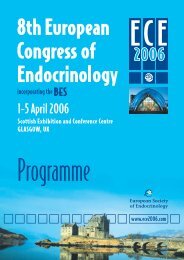
![The Endocrinologist | Issue 99 [PDF] - Society for Endocrinology](https://img.yumpu.com/48213777/1/184x260/the-endocrinologist-issue-99-pdf-society-for-endocrinology.jpg?quality=85)
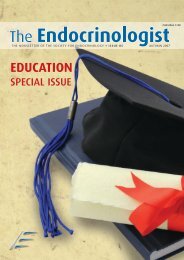
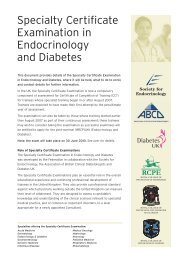
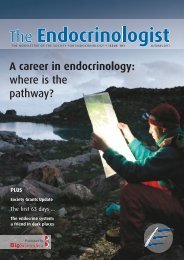
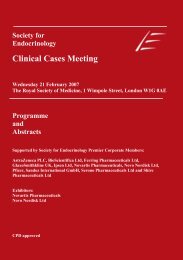

![The Endocrinologist | Issue 97 [PDF] - Society for Endocrinology](https://img.yumpu.com/40840065/1/184x260/the-endocrinologist-issue-97-pdf-society-for-endocrinology.jpg?quality=85)
